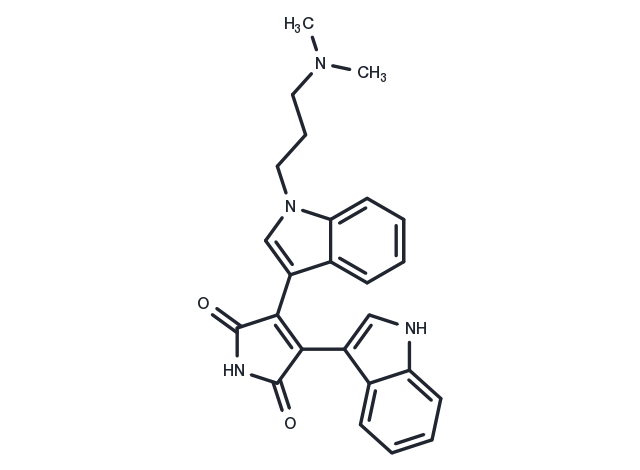Powder: -20°C for 3 years | In solvent: -80°C for 1 year


Bisindolylmaleimide I (GF109203X) is a potent and highly selective protein kinase C (PKC) inhibitor with a Ki of 14 nM.

| Pack Size | Availability | Price/USD | Quantity |
|---|---|---|---|
| 5 mg | In stock | $ 61.00 | |
| 10 mg | In stock | $ 101.00 | |
| 25 mg | In stock | $ 198.00 | |
| 50 mg | In stock | $ 369.00 | |
| 100 mg | In stock | $ 493.00 | |
| 1 mL * 10 mM (in DMSO) | In stock | $ 66.00 |



| Description | Bisindolylmaleimide I (GF109203X) is a potent and highly selective protein kinase C (PKC) inhibitor with a Ki of 14 nM. |
| Targets&IC50 | PKC:14 nM |
| In vitro | GF109203X, as an ATP-competitive PKC inhibitor, prevents platelet aggregation induced by stimuli that activate PKC, and has the potential as a tool for studying the involvement of PKC in signal transduction pathways. [1] GF 109203X produces reversal activity on P-glycoprotein and MRP -mediated multidrug resistance. [2] [3] PKC inhibition by GF109203X significantly reduces carbachol-stimulated ERK1/2 activation and the subsequent proliferation of SNU-407 colon cancer cells. [4] |
| In vivo | GF109203X (10 μg/mouse, i.pl.) dose-dependently inhibits BK-induced mechanical allodynia in Wistar rats. [5] |
| Kinase Assay | Assay of protein kinase C: Protein kinase C is arrayed by measuring 32PI transferred from [gamma-32PI] ATP to lysine-rich histone type Ill-s. The reaction mixture (80 μL) contained 50 mM Tris-HCI. pH 7.4, 100 μM CaCl2, 10 mM MgCI2, 37.5 μL/mL histone type Ill-s, 10 μM [gamma-32PI] ATP (1250 cpm/pmol), 31 μM bovine brain phosphatidylserine and 0.5 μM 1,2 sn-dioleylglycerol. Fifteen μL of purified PKC (final concentration in assay 0.38 μg/mL) is added to the incubation mixture. After 10 min at 30°C, the reaction is stopped by addition of 30 μL of casein 30 mg/mL and 0.9 ml of 12% trichloroacetic acid. The acid precipitable material is collected by centrifugation, dissolved in 1N NaOH (100μL) and precipitated again with 1 ml of 12% trichloroacetic acid. The pellet is dissolved in 1N NaOH (100μL) and 32P incorporation is measured by scintillation counting in Aquasol. |
| Cell Research | Cell proliferation is monitored by the 3-(4,5-dimethylthiazol-2-yl)-2,5-diphenyl tetrazolium bromide (MTT) assay. Cells are seeded in 96-well plates and allowed to grow overnight. The cells are serum-starved for 18–24 hours and then treated with 1 mM carbachol for 48 hours in 100 μL serum-free RPMI 1640. Inhibitors are added 30 min prior to carbachol treatment. Following the treatment, 10 μL of MTT solution (5 mg/ml) is applied to each well, and the plates were incubated for 3 h at 37 °C. After the medium is removed, the formazan crystals formed are solubilized in 100 μL DMSO. The absorbance at 570 nm is measured using a microplate reader and the background absorbance at 690 nm is subtracted. Each assay is performed in triplicate. (Only for Reference) |
| Synonyms | GF109203X, Go 6850 |
| Molecular Weight | 412.48 |
| Formula | C25H24N4O2 |
| CAS No. | 133052-90-1 |
Powder: -20°C for 3 years | In solvent: -80°C for 1 year
DMSO: 10.3 mg/mL (25 mM)
You can also refer to dose conversion for different animals. More
bottom
Please see Inhibitor Handling Instructions for more frequently ask questions. Topics include: how to prepare stock solutions, how to store products, and cautions on cell-based assays & animal experiments, etc.
Bisindolylmaleimide I 133052-90-1 Angiogenesis Chromatin/Epigenetic Cytoskeletal Signaling Tyrosine Kinase/Adaptors PDGFR PKC Go6850 Protein kinase C Go-6850 GF109203X inhibit Go 6850 Inhibitor inhibitor
